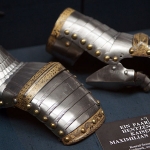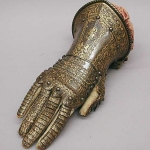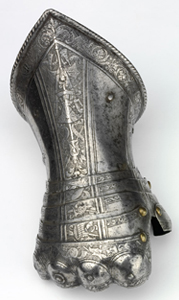No products in the cart.
 The expression ‘throwing down the gauntlet’ stems from the middle ages and is literally a call to arms. One look at the medieval gauntlet, often featuring knuckledusters design to maximize punishment when resorting to punches, and it’s easy to understand how the gauntlet became a symbolic call to arms.
The expression ‘throwing down the gauntlet’ stems from the middle ages and is literally a call to arms. One look at the medieval gauntlet, often featuring knuckledusters design to maximize punishment when resorting to punches, and it’s easy to understand how the gauntlet became a symbolic call to arms.
Early metal plate hand protection began during the late 12th century when the mail sleeves of the hauberk were elongated into a mitten. Worn above a leather glove, mail armor protected the fingers, along with a single armor plate. This pattern of armored hand protection was worn until the end of the 13th century.
By the early 14th century, mail gloves with separate fingers started to appear as an extension of the sleeve plates. These extensions covered the backside of the hand, offering greater protection, from the wrist to the end of the metacarpals. Bordered by the thumb joint, embossed around the finger joints and base of the thumb, the design included overlapping plates that covered the individual fingers and cuff.
 In their earlier forms, these armoured gloves were known as hourglass gauntlets due to the widening plated geometry over the back of the hand, which narrowed at the wrist and flared at the cuff. Generally, only the thumb was articulated with mechanical plates while the fingers were protected by a solid top plate, riveted to mail or leather gloves. This type of armour remained in vogue until the fifteenth century, when the cuff narrowed to protect against the threat of a sword thrust through the flared gap. This change was in response to the changing blade geometry of the medieval sword, which began to appear at the end of the 14th century. As such, the cuff plate of the medieval gauntlets grew smaller, and the wrist and finger protection changed from one piece to multiple interlocking plate construction that facilitated greater wrist and finger motion. Heres an example of a modern-day gauntlet.
In their earlier forms, these armoured gloves were known as hourglass gauntlets due to the widening plated geometry over the back of the hand, which narrowed at the wrist and flared at the cuff. Generally, only the thumb was articulated with mechanical plates while the fingers were protected by a solid top plate, riveted to mail or leather gloves. This type of armour remained in vogue until the fifteenth century, when the cuff narrowed to protect against the threat of a sword thrust through the flared gap. This change was in response to the changing blade geometry of the medieval sword, which began to appear at the end of the 14th century. As such, the cuff plate of the medieval gauntlets grew smaller, and the wrist and finger protection changed from one piece to multiple interlocking plate construction that facilitated greater wrist and finger motion. Heres an example of a modern-day gauntlet.
The Medieval Gauntlet of the 14th Century knight
During the 14th century advances in the blacksmith trade resulted in the construction of plate metal armour with increased artistry and articulation. The ability to craft articulated plate defences, fitted to individual fingers maximized a knight’s defensive and aggressive capacities by liberating the fingers and wrists to move more naturally.
 As stated by Historian Michael P. Smith, common features of the late medieval design included spiked knuckle plates and protrusions off the third knuckle on the metacarpal plate known as gadlings. “Another very important feature on most, if not all, medieval gauntlets of this style, is the so-called “knuckle-rider” plate. This is a plate between the metacarpal plate and the finger plates. It is articulated with rivets to the metacarpal plate and is attached to the finger leathers… This allows the plate to cover the gap between metacarpal plate and the finger plates, while allowing the fingers to be fully extended.”
As stated by Historian Michael P. Smith, common features of the late medieval design included spiked knuckle plates and protrusions off the third knuckle on the metacarpal plate known as gadlings. “Another very important feature on most, if not all, medieval gauntlets of this style, is the so-called “knuckle-rider” plate. This is a plate between the metacarpal plate and the finger plates. It is articulated with rivets to the metacarpal plate and is attached to the finger leathers… This allows the plate to cover the gap between metacarpal plate and the finger plates, while allowing the fingers to be fully extended.”
 The last half of the 15th century saw armoury reach its apex in both form, function and ingenuity. The craft of the blacksmiths during the late medieval period employed elegant mechanics that further freed both the wrist and fingers to move with even greater independence. So by the 16th century when someone threw down the gauntlet there was no denying the significance of the act; more than just a protective armour, the gauntlet was literally regarded as the hand of war.
The last half of the 15th century saw armoury reach its apex in both form, function and ingenuity. The craft of the blacksmiths during the late medieval period employed elegant mechanics that further freed both the wrist and fingers to move with even greater independence. So by the 16th century when someone threw down the gauntlet there was no denying the significance of the act; more than just a protective armour, the gauntlet was literally regarded as the hand of war.





helps when its simple as this
Awesome Breakdown on Gauntlets thank you